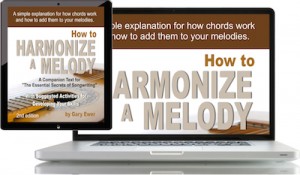I’ve recently returned to listening to an album that really impressed me when it was released in 2015: “Carrie & Lowell,” by American singer-songwriter Sufjan Stevens. I hope you take the time to give it a listen.
What I love the most about it is its transparency of sound. With simple guitar and keyboard accompaniments, an album like this helps me focus, and wonder, when I listen to other albums, what all the noise is all about.
 Have a great melody, but stuck at the “how to add chords to it” stage? “How To Harmonize a Melody” shows you, step-by-step and with sound samples, how it’s done, with suggestions for chord substitutions that might work as well. It’s part of “The Essential Secrets of Songwriting” 10-eBook Bundle.
Have a great melody, but stuck at the “how to add chords to it” stage? “How To Harmonize a Melody” shows you, step-by-step and with sound samples, how it’s done, with suggestions for chord substitutions that might work as well. It’s part of “The Essential Secrets of Songwriting” 10-eBook Bundle.
I think one of the real gems on that recording is “Eugene“:
“Eugene” offers three melodies, but avoids arranging them in verse-chorus-bridge fashion. It’s all the evidence you need that strong chorus hooks aren’t a necessity if you’ve got a strong lyric and well-contoured melodies.
But it takes more than the simple decision to write a 3-melody song. Verse-chorus designs have a way of enticing listeners to keep listening because we hear the interplay of rising and falling melodies, and the rising and falling emotional energy that happens. So how do you achieve fluctuating musical energy if you purposely avoid that most common of song designs?
It can be very liberating to write a song where you don’t fixate on chorus hooks. So if you’re interested in trying your hand at writing a 3-melody song, here are some guidelines:
- Pull your audience in with the simplicity of your melodies. Simple diatonic melodies (i.e., melodies that don’t stray from your chosen key at all) with simple rhythms that come from the natural pulse of the lyric will entice your audience to keep listening.
- Find a way to contrast Melody 1 from Melody 2. In “Eugene”, Stevens starts the first melody on the 6th note of the key (B major), over a IV-chord (E), and moves the melody higher. Melody 2 starts on that same 6th note, but moves down. In songwriting, melodic direction is a large part of controlling musical energy. We hear it increase when vocal lines ascend, and dissipate when they descend.
- Find alternate ways of creating contrast. Contrasting melodic direction is a good one, but there are other ways to contrast melodies: 1) changing from major to minor; 2) changing the basic rhythms you use; 3) changing instrumentation, etc.
- Create a Melody 3 that differs in some special way from the first two. Stevens starts both of his first two melodies on the 6th note, moving upward for Melody 1 and downward for Melody 2. In his third melody, he starts on high F# — the highest note of the song, in fact — and it’s all he needs to do to create a melody that sounds different enough that the musical journey continues.
In the final design, Steven gives us this:
Mel #1 – Mel #2 – Mel #1 – Mel #2 – Mel #3 (rpt) – Mel #1 – Mel #2 – Mel #1 – Mel #2
With this design, he gives us what we might call an arch form, where the middle 3rd melody is enveloped within Melodies 1 and 2.
With arch form, the sense of musical journey is very strong. He uses the lyrical line “I just wanted to be near you” (or something similar) as a strong organizing feature, a line that happens at the end of each occurrence of the 2nd melody, and again at the end of the 3rd.
That repeating line of lyric offers something to the listener that helps them feel a stronger sense of form. In a sea of narrative-style lyrics — and very wordy at that — the “I just wanted to be near you” line offers a crucial bit of repetition that acts like an important punctuation mark: a point of focus.
If you want to try a 3-melody song, just remember: contrast is vital. It doesn’t need to be overly contrasting, but needs to be there in order to avoid your song sounding like an aimless and meaningless wandering of different melodic ideas.
 Written by Gary Ewer. Follow Gary on Twitter.
Written by Gary Ewer. Follow Gary on Twitter.
 Get “The Essential Secrets of Songwriting” eBooks. They’ll help you polish your technique, and make you the best songwriter you can be. Comes with a Study Guide, tons of chord progressions, and information covering every aspect of how to write good music. Get TODAY’S FREE DEAL.
Get “The Essential Secrets of Songwriting” eBooks. They’ll help you polish your technique, and make you the best songwriter you can be. Comes with a Study Guide, tons of chord progressions, and information covering every aspect of how to write good music. Get TODAY’S FREE DEAL.











Hi Gary, check out these songs that demonstrate the concept of using very few different melodies. They all have less than three, some only having one that is slightly varied throughout the song. All different genres:
Kris Kristofferson – Sunday Morning Coming Down
Wilson Pickett – In the Midnight Hour
Neil Young – Helpless
Sam Cooke – A Change Is Gonna Come
Johnny Cash – I Walk the Line
The Miracles – Shop Around
Gordon Lightfoot – Wreck of the Edmund Fitzgerald (only one melody!)
Thanks Neo, these are great examples. I’ll point out that this post wasn’t trying to imply that you can’t write a melody with less than 3 melodies, but that a 3-melody song gives us an arch form which is an interesting and useful song design, particularly for controlling musical energy.
Many thanks,
-Gary
Oh most definitely! I was just throwing in examples to add 🙂
Also on a similar subject, have you heard of sequences before? It would probably be best for a separate article, but sequences are little fragments within melodies (or sometimes even small melodies themselves) that are repeated at successively lower or high pitches, usually two or three times. See these example songs below. Pretty much the entire songs are based around these simple ideas:
The Beatles – Norwegian Wood:
“I once had a girl, or should I say, she once had me”
“Isn’t it good? Norwegian Wood”
The Beatles – Eleanor Rigby:
“Picks up the rice in a church where a wedding has been”
The Beatles – Across the Universe:
“Words are flowing out like endless rain into a paper cup”
Stan Getz – The Girl from Ipanema:
“Tall and tan and young and lovely, the girl from Ipanema goes walking,
and when she passes, each one she passes goes…”
Rolling Stones – I Can’t Get No Satisfaction:
“I can’t get no, satisfaction”
Thanks for post this awesome!. I’m a long time reader but
ive never commented till now. I’ve shared this on facebook for my followers.
Thanks again for the awesome post.
Thanks very much for sharing, and I’m very glad you liked the post.
Cheers!
G